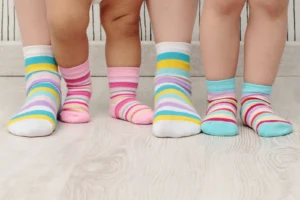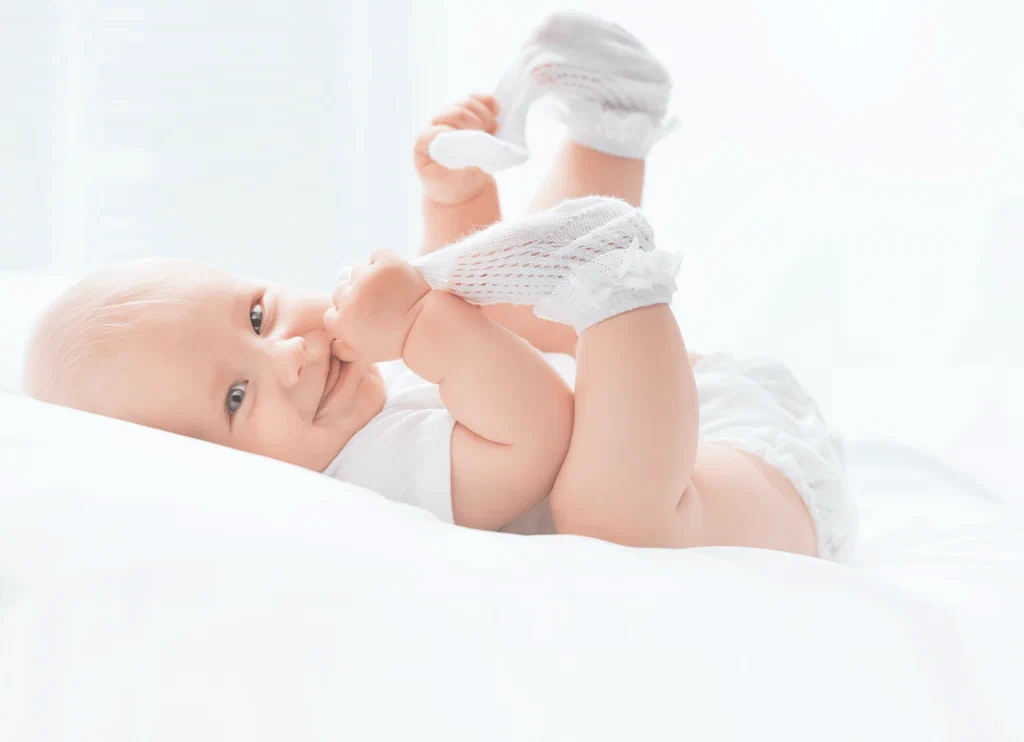Every parent has faced the frustrating battle of keeping socks on their baby’s feet. One moment they’re cozy and warm, the next, one sock is lost in the abyss of the car seat, stroller, or grocery store aisle. So how can you keep those tiny socks from constantly slipping off? In this article, we’ll explore 15 foolproof strategies to keep your baby’s feet snug and secure. Discover how to keep socks on your baby.
Let’s dive in and say goodbye to the endless sock hunt!
Why Babies Lose Their Socks
1.1 Babies’ Constant Movement
Babies are natural wiggle machines. Whether they’re kicking, squirming, or exploring the world, all that movement can easily dislodge their socks. Unlike adults, babies don’t understand the need to keep their feet covered, making socks an easy target for curious toes and busy hands.
1.2 Sock Fit and Material Issues
Another major reason socks fall off is poor fit or the wrong materials. Socks that are too tight may slip off as babies move, while loose socks can easily get kicked off. Additionally, some fabrics, like stiff cotton blends, don’t grip as well as others. Choosing the right fit and material is key to keeping socks on.
Choosing the Right Baby Socks
2.1 Importance of Sock Fit
Choosing the correct size is essential. Baby socks should be snug, but not tight, around the ankles and feet. They should stay in place without leaving red marks or indentations. Opt for socks with elastic bands that gently hug your baby’s foot without constricting circulation.
2.2 Best Materials for Baby Socks
Soft, stretchy materials work best for babies. Fabrics like:
- Cotton blends with elastane or spandex for flexibility
- Bamboo for breathability and softness
- Merino wool for warmth and moisture-wicking properties
Avoid stiff or scratchy materials that can cause discomfort or slip easily.
2.3 Types of Socks That Stay Put
Look for socks specifically designed to stay on, such as:
- Grip socks with silicone dots
- Elastic-cuff socks that gently hold the ankle
- Fold-over socks with an extra cuff layer for security
Brands like Gerber, Trumpette, and Jefferies Socks offer reliable options.

Sock Clips and Fasteners
Sock clips and fasteners are game-changers for keeping socks on. These clever accessories attach to your baby’s socks and pants, preventing socks from slipping off. Brands like Sock-Ons offer stretchy, easy-to-use bands that secure socks without discomfort. They’re ideal for everyday use and can save you from constantly searching for missing socks.
Baby Booties: A Secure Alternative
Booties are a great alternative to socks. They’re designed to stay on with features like adjustable straps, snaps, or elasticized openings. Brands like Zutano and Robeez offer soft, secure booties that are both stylish and practical. Booties are perfect for babies who tend to lose socks easily.
Layering Socks Under Pants
A simple but effective trick is tucking socks under your baby’s pants. Pulling pants over the sock cuffs can create a barrier that helps socks stay put. This method works best with stretchy, snug-fitting pants like leggings or joggers.
Sock-Staying Brands to Consider
Some brands are known for making baby socks that stay on. Here are a few parent favorites:
- Trumpette – Stylish and snug socks with elastic bands.
- Jefferies Socks – High-quality socks with excellent grip.
- Hanes – Affordable options with comfort and elasticity.
- Gerber – Reliable baby socks with stretchable cuffs.
- Zutano Booties – Perfect for newborns and active infants.
Investing in these brands can save you the hassle of constantly replacing lost socks.
Using Sock-Ons or Sock Garters
Sock-ons are specially designed elastic bands that slide over your baby’s socks to keep them in place. These simple yet effective accessories ensure socks stay on even during intense kicking sessions. They’re soft and safe, and don’t leave marks on delicate baby skin.
Alternatively, sock garters provide a similar solution by gently securing socks at the ankles. Both options are easy to use, cost-effective, and widely available online or at baby stores. Parents who have tried Sock-Ons often rave about their effectiveness in preventing sock loss.
Onesies with Built-in Footies
Footed onesies are a lifesaver when it comes to keeping little feet covered. These one-piece outfits include built-in socks (also known as footies) that can’t slip off. They’re perfect for cold weather or bedtime, ensuring your baby stays warm and snug throughout the night.
When selecting footed onesies, opt for:
- Zippered onesies for quick diaper changes
- Snap closures for added flexibility
- Fleece-lined options for extra warmth
Brands like Carter’s, Burt’s Bees Baby, and Little Sleepies offer high-quality footed onesies that combine comfort and practicality.
Fold-Over Cuffs for Extra Grip
Fold-over cuffs provide an additional layer of grip around your baby’s ankles. Many baby socks come with cuffs that can be folded down for a snug fit or pulled up for extra coverage. This feature helps keep socks secure and prevents them from sliding off during movement.
When shopping for fold-over socks, consider options made from:
- Stretchy cotton blends for flexibility
- Terry cloth for added warmth
- Wool blends for colder weather
These socks offer versatility and a secure fit, making them a staple for any baby’s wardrobe.
Baby Shoes: Do They Help?
While baby shoes aren’t necessary for non-walking infants, they can help keep socks on during outings. Soft-soled baby shoes or pre-walkers add a layer of protection and hold socks in place.
When choosing baby shoes, look for:
- Soft, flexible soles that mimic natural foot movement
- Velcro straps for easy adjustments
- Breathable materials to prevent overheating
Brands like Robeez, Stride Rite, and See Kai Run offer excellent options for pre-walking babies. Remember, comfort and flexibility are key to keeping your baby happy while securing those socks!
When to Go Sock-Free
Sometimes, the best solution is simply to let your baby go sock-free. If you’re indoors and the temperature is warm, allowing your baby’s feet to remain bare can be beneficial. It promotes natural development, improves sensory feedback, and helps babies learn to use their toes for balance.
Consider going sock-free when:
- The environment is warm and comfortable
- Your baby is playing on a soft, clean surface
- You want to encourage foot and toe movement
Just keep an eye on the room temperature to ensure your baby doesn’t get cold.
DIY Solutions for Keeping Socks On
If you’re feeling crafty, there are several DIY methods to keep socks in place:
- Sewing elastic bands into the cuffs of baby socks for a custom fit.
- Using hair ties (loosely) over socks for temporary grip.
- Create sock clips by attaching small binder clips to your baby’s pants and socks.
These homemade solutions can be quick fixes, but always ensure they’re safe and comfortable for your baby.

Tips for Older Babies and Toddlers
As babies grow into toddlers, the sock struggle can continue. Here are some tips for keeping socks on older babies:
- Choose fun, colorful socks that your toddler enjoys wearing.
- Involve them in the process by letting them choose their socks.
- Use non-slip socks for added grip during playtime.
- Reinforce habits by explaining the importance of keeping feet warm.
Making socks fun and engaging can help older babies and toddlers keep them on willingly.
Common Mistakes to Avoid
Keeping socks on your baby can be tricky, but avoid these common mistakes:
- Buying socks that are too tight or too loose. Proper fit is key to keeping socks secure.
- Ignoring material quality. Choose breathable, stretchy fabrics for comfort.
- Overlooking sock alternatives. Booties, footed onesies, and sock clips can be lifesavers.
- Neglecting seasonal needs. Ensure socks are warm in winter and breathable in summer.
Avoiding these pitfalls can make the sock-wearing experience smoother for both you and your baby.
Conclusion
Keeping socks on a baby doesn’t have to be an endless struggle. By choosing the right fit, materials, and accessories, you can ensure your baby’s feet stay warm and cozy. From using Sock-Ons and booties to opting for footed onesies, these tips will help you tackle the sock battle with confidence. No more lost socks or cold toes—just happy, warm feet for your little one!
FAQs
1. Why do my baby’s socks keep falling off?
Babies’ constant movement and poorly fitting socks are the most common reasons socks fall off. Choosing the right size and materials helps keep socks secure.
2. Are booties better than socks for newborns?
Yes, booties often stay on better than socks due to their adjustable straps or elastic openings. They’re a great option for newborns.
3. What are Sock-Ons, and do they work?
Sock-ons are elastic bands that fit over baby socks to keep them in place. They’re effective and popular among parents for preventing lost socks.
4. How can I keep socks on during sleep?
Footed onesies or sleep sacks with built-in footies are ideal for keeping socks on during sleep. They provide warmth and stay put.
5. Should babies always wear socks?
Not necessarily. If the temperature is warm and the environment is safe, going sock-free can benefit your baby’s foot development.

